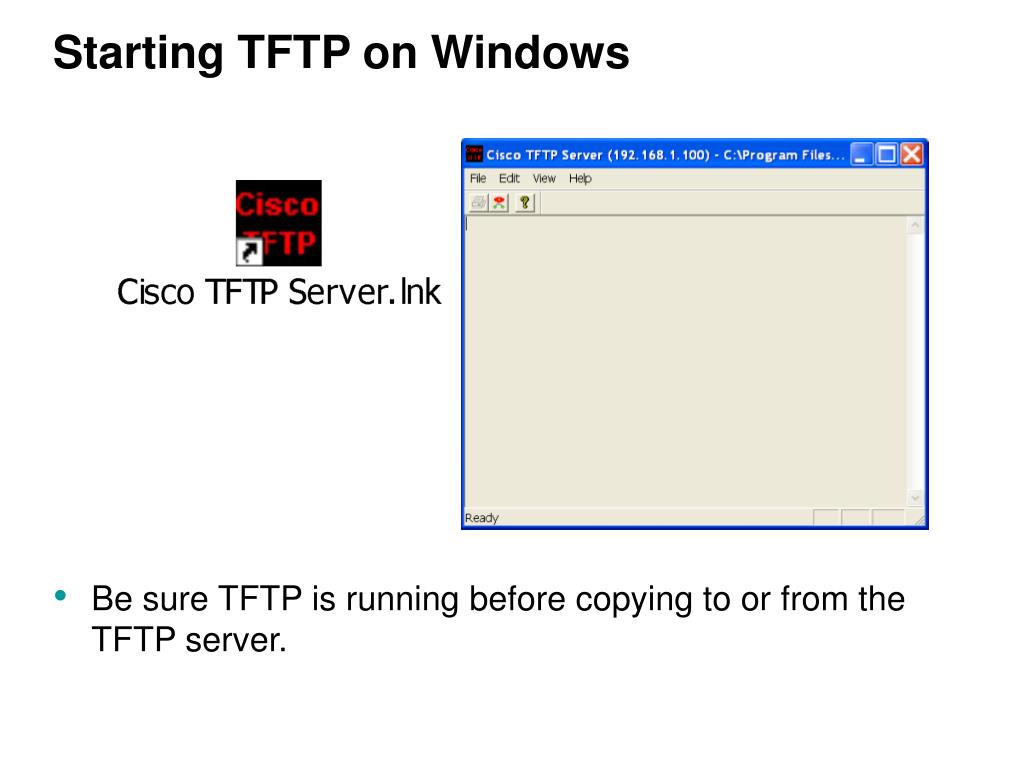

- CISCO IOS COPY LOG TFTP HOW TO
- CISCO IOS COPY LOG TFTP FULL
- CISCO IOS COPY LOG TFTP SOFTWARE
- CISCO IOS COPY LOG TFTP PLUS
TFTP generates the following special characters to help you determine why a TFTP session fails: Saves the running configuration to the startup configuration file. Router# copy running-config startup-config You can enter multiple lines to specify multiple images.Įnds the configuration session and returns you to privileged EXEC mode.

Specifies the system image to send in response to Read Requests. Router(config)# tftp-server rom alias filename1

Router(config)# tftp-server flash filename1 To enable TFTP server operation, use the following commands, beginning in privileged EXEC mode: Example configurations for the Flash server and client routers include commands as necessary. In the description that follows, one router is referred to as the Flash server, and all other routers are referred to as client routers. Some Cisco devices allow you to specify one of the different Flash memory locations ( bootflash:, slot0:, slot1:, slavebootflash:, slaveslot0:, or slaveslot1:) as the TFTP server. This feature allows you to boot a remote router with an image that resides in the Flash server memory. The TFTP Read Request message must use one of the filenames that are specified in the configuration.įlash memory can be used as a TFTP file server for other routers on the network.
CISCO IOS COPY LOG TFTP SOFTWARE
For example, if the server has X.25 software, and the client does not have X.25 software in ROM, the client will not have X.25 capabilities after booting from the server's image in Flash memory.Īs a TFTP server host, the router responds to TFTP Read Request messages by sending a copy of the system image contained in ROM or one of the system images contained in Flash memory to the requesting host.
CISCO IOS COPY LOG TFTP FULL
Note the name of this software image so you can verify it after the first client boot.Ĭaution For full functionality, the software image sent to the client must be the same type as the ROM software installed on the client router. This is the system software image the client router will boot. If the connection fails, reconfigure the interface, check the physical connection between the Flash server and client router, and ping again.Īfter you verify the connection, ensure that a TFTP-bootable image is present on the server.
CISCO IOS COPY LOG TFTP PLUS
After the ping command is issued, connectivity is indicated by a series of exclamation points (!), while a series of periods (.) plus or indicates that the connection attempt failed. Verify this connection by testing the connection between the server and client router (in either direction) using the ping a.b.c.d command (where a.b.c.d is the address of the client device). The server and client router must be able to reach each other before the TFTP function can be implemented. TFTP Router Configuration Prerequisite Tasks You can also configure the router to respond to other types of service requests, such as requests. Typically, a router that is configured as a TFTP or RARP server provides other routers with system image or router configuration files from its Flash memory. You can configure a router to serve as a RARP or TFTP server to reduce costs and time delays in your network while allowing you to use your router for its regular functions. However, when you do not have a server on every segment, your network operations can incur substantial time delays across network segments. It is too costly and inefficient to have a machine that acts only as server on every network segment. Configuring a Router as a TFTP or RARP Server Feature Information for Configuring Basic File Transfer ServicesĪll tasks in this chapter are optional.Configuring a Router to Use FTP Connections.Configuring a Router to Use rsh and rcp.Configuring a Router as a TFTP or RARP Server.To configure basic file transfer services, perform any of the tasks described in the following sections: Basic File Transfer Services Configuration Task List To access Cisco Feature Navigator, go to. Use Cisco Feature Navigator to find information about platform support and Cisco IOS XE software image support. To find information about the features documented in this module, and to see a list of the releases in which each feature is supported, see the "Feature Information for Configuring Basic File Transfer Services" section. Finding Feature Informationįor the latest feature information and caveats, see the release notes for your platform and software release.
CISCO IOS COPY LOG TFTP HOW TO
This module describes how to configure a router as a Trivial File Transfer Protocol (TFTP) or Reverse Address Resolution Protocol (RARP) server, configure the router to forward extended BOOTP requests over asynchronous interfaces, and configure rcp, rsh, and FTP.


 0 kommentar(er)
0 kommentar(er)
